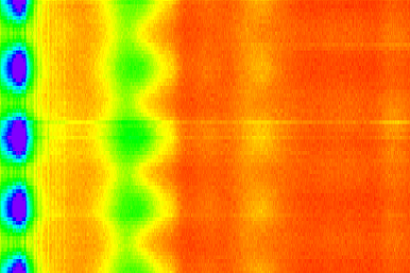We devote a lot of effort to understand the nanoscale phenomena in chemically disordered dielectric materials. These materials exhibit exceptionally large piezoelectric and dielectric responses and are therefore utilized in vast number of devices. However, due to their complexity at different scales, they are by far not well understood yet, which hinders the efforts to fully exploit their potential. We work in a close cooperation with experiment to shed light on mechanisms behind their performance.
Our tools are dominantly numerical large-scale molecular-dynamics simulations. The interactions between individual atoms are treated classically in order to allow for large and long-enough simulations, necessary for extraction of spatial and time correlations. The simulations allow us to extract the diffuse scattering paterns reflecting static chemical as well as dynamical/vibrational disorder, and compare them directly to experimental data. As the relevance of the obtained results strongly depend on the quality of parametrers characterizing the interatomic interactions, we built the comptetence of developing new and improving exiting models. Using carefully chosen models, the simulated and experimentally obtained results are remarkably similar, indicating that they capture well the physics of atomic interactions.
SrxBa1-xNb2O6 (SBN) is one of the materials of interest. This solid solution has a tunable ferroelectric behaviour – it can be a 'normal' ferroelectric with a sharp phase transition at a certain temperature for small Strontium concentrations or a 'relaxor' material in which the dielectric permittivity has an anomaly in a broad temperature range which additionally depends on the frequency of the probing electric field. The relaxor behaviour is usually attributed to the existence of small polar clusters or nanodomains. These have been extensively studied by a combination of neutron scattering techniques and phenomenological modeling. An atomic-level combination of theory (using first-principles quantum-mechanical calculations) and a scattering-based analysis (neutron pair distribution function) yields a picture of two polarization sublattices influenced by the chemical disorder and a short-range nature of non-polar distortions. A raman scattering experiment in conjunction with an infra-red and THz spectroscopic methods, covering together a broad frequency range, also indicate on an existence of more then one polarization mechanism contributing to the complicated dielectric behaviour of the relaxor SBN.
Another chemically disordered material is the PbZr1-xTixO3 (PZT), which is one of the most used piezoelectric compounds with superior electromechanical properties at special composition ratio of Zr and Ti atoms (called morphotropic phase boundary region). The random distribution of these ions makes any analysis of experimental data notoriously difficult. However a purposely designed mathematical analysis of the Raman spectra based on their frequency derivatives was instrumental in unveiling a 'hidden' contributions to the recorded signal. This helped to clarify the nanoscale picture of this material in the interesting compositional range. A follow-up study, again using broad range of probing frequencies, showed how a mesoscale structural features – domain walls and grain boundaries – dominate the dielectric response at room temperature and below.








